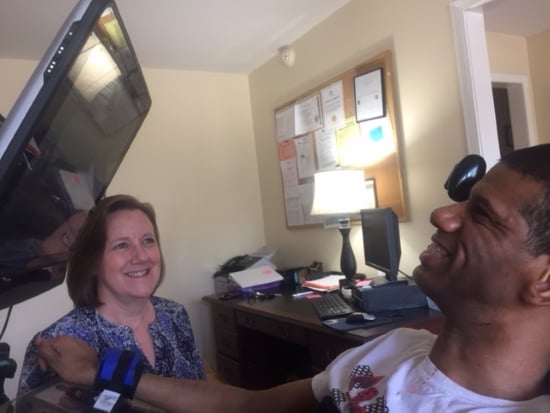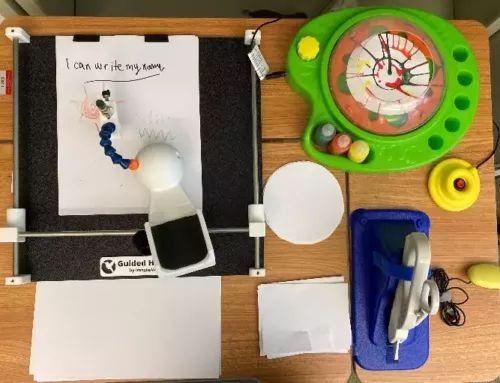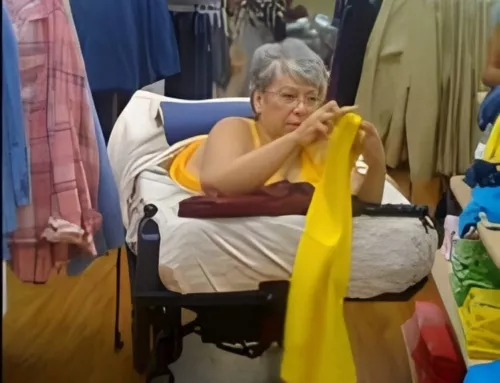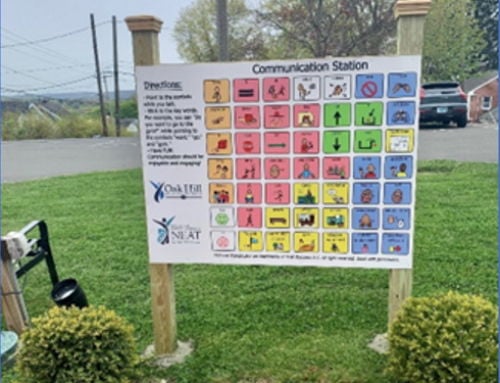Better Access to Eye-Gaze Communication Comes to South Carolina

Talk isn’t cheap if you need an eye-gaze device! The South Carolina AT Program gets help from the Christopher and Dana Reeve Foundation.

Carol Page and Michael Leaphart
Ten years ago Carol Page, Ph.D., CCC-SLP, ATP, CBIS, Director of the South Carolina Assistive Technology Program (SCATP) met Michael Leaphart at a Tobii communication device training. Leaphart attended with support staff from his community residence. At 35 years old, he was not using a speech-generating device despite living without intelligible speech his entire life. At the training, Leaphart tried out a number of devices and was quickly navigating a communication display comfortably with eye gaze. Page was impressed.
At that time, SCATP had no eye-gaze communication devices in its device loan inventory. Like all State and Territory AT Programs, SCATP has a library of equipment available for borrowing for two-to-four week loan periods free of charge. There is also an AT Exchange where people list equipment they are no longer using for donation or sale, and an AT Reuse program that refurbishes and reassigns donated equipment at no cost. Eye-gaze equipment is expensive for a loan library to stock, however, and eye-gaze donations are rare.
As a speech-language pathologist (SLP) who trains users on communication devices, Page was haunted by Leaphart’s situation and frustrated not to have the equipment he needed to borrow to make his case to Medicaid. Eye-gaze control is an area of AT that has made tremendous advancements in recent years. Users hover their gaze over words, letters or icons arranged on a monitor. The system tracks their pupils to trigger pre-recorded messages or read aloud words or entire sentences built with word prediction and the alphabet. People who use eye gaze for communication can now also access the internet, create documents, join social media, play music and control their environments. The systems require training, however, and they cost thousands of dollars.
When eventually an eye-gaze communication system was donated to the Reuse program, Page jumped at the opportunity for Leaphart. It was an older model, but he mastered it, and she kept it functioning until funding materialized for his own new system. Page recalls her first visit to Leaphart’s community residence when the donated device became available; staff was reciting the alphabet and Leaphart would raise his eyes to choose a letter. Leaphart had waited five years for this first device, “Way too long,” Page acknowledges. “He was working to spell DVD, and ‘V’ is a long way down the alphabet.”
Clearly, something had to change.
This January SCATP was awarded a Christopher and Dana Reeve Foundation High Impact Innovative Assistive Technology grant to increase access to eye-gaze communication systems in South Carolina. The grant is providing four new eye-gaze systems of different varieties to the SCATP device loan library. Over twelve months, SCATP expects 20 individuals with disabilities to access communication, the internet and control their environments (lights, TV, heat, etc.) with this equipment (and sometimes the addition of an Amazon Echo). “These systems have the power to end a lifetime of frustration and open up the world,” Page says. “We’re so grateful to the Reeve Foundation to have this opportunity.”
SCATP will provide training to eye-gaze device borrowers and their family members, support staff, SLPs and other area professionals working with clients who can benefit. Each training will be for the team of a specific person since users’ needs are highly individualized.
Before the Reeve Foundation grant, Page was able to collect several eye-gaze systems for the SCATP device loan program. The devices meant individuals could try a device for two weeks and renew for a second two-week loan period if there were no waiting list. These loan periods proved cumbersome for eye-gaze systems, however. The devices were in demand and two weeks were not enough to make the case to Medicaid or other insurers. What was needed was a larger inventory of devices, a variety of eye-gaze options, and an extended loan period that could accommodate the needed training with support staff, family members, and individual users. People needed time to get the device correctly configured and time to explore a user’s potential. Page recalled when Leaphart made his first call to his mother and how she’d became audibly emotional to hear from her son…
The loan period for devices funded by the Reeve Foundation will be two months, plenty of time to document progress with it to public and private insurers. Significantly, the trainings and devices will provide professional development opportunities for speech-language pathologists with little or no experience using eye-gaze devices. “If this project can lessen the intimidation professionals feel about these systems, we will go a long way toward real change for people who need them in South Carolina,” Page acknowledges.
Beyond the grant-funded period, Page sees the opportunity to make devices available for long-term device loan as well. People with ALS, for example, who may have only a few months to live, do not need the anxiety of losing access to their communication system.
As of this writing, the SCATP Reeve project is just getting underway. SCATP is identifying potential eye-gaze users through new program partnerships and has received its first referral from a local hospital. Outreach is proceeding with assistance from the Spinal Cord Injury Association, Traumatic Brain Injury Association, Cerebral Palsy Association, the ALS Association of South Carolina, and the Muscular Dystrophy Association of Greater South Carolina among other entities.
Today Michael Leaphart enjoys Facebook, and he manages his life via email, including writing to Page. Page has helped him obtain tutoring with spelling, vastly improving his communication. He advocates for himself. He also advocates for other adults in his day program (she hears from him about people who need communication devices). Page says he has no idea all that he has inspired for South Carolina. This week she plans to tell him.
Monthly Blog Digest
Search the blog
State AT Program Blogs
California
Florida
Indiana
Kentucky
Louisiana
Maryland
Massachusetts
Michigan
Montana
North Carolina
North Dakota
Utah
State AT Program Blogs
The AT3 Center, the Association of AT Act Programs (ATAP), and the Administration on Community Living (ACL) make no endorsement, representation, or warranty expressed or implied for any product, device, or information set forth in this blog. The AT3 Center, ATAP, and ACL have not examined, reviewed, or tested any product or device hereto referred.







